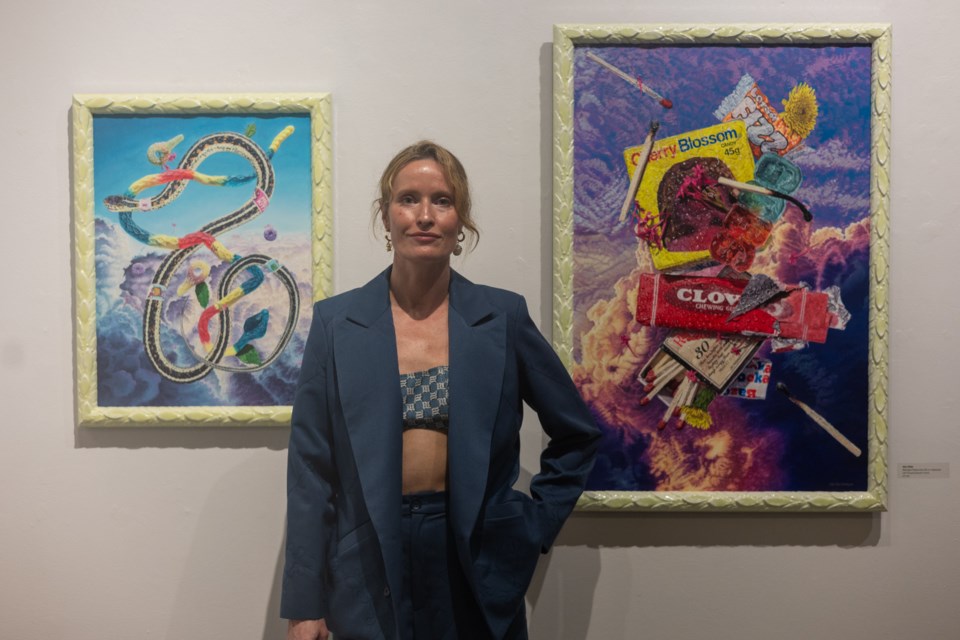At crowded art openings at The Kube gallery in Gibsons, it’s not uncommon for the featured artist to beam with satisfaction. In the case of Caroline Weaver’s show of luminescent paintings, the artworks glowed as well.
Weaver, a self-taught oil painter based in Halfmoon Bay, launched her showcase titled Flashlight Tag on Nov. 8. Her paintings blur the boundary between collage and photo-realistic representations: each work in the series meticulously arranges oversize ephemera of contemporary life (lighters, matchbooks, energy drinks) against iridescent skies. Weaver employs a type of paint that responds to blacklight; the ornate frames glow eerily green as well.
“I’ve been working with nostalgia,” Weaver explained, “revisiting the past and looking backwards in detail. It means not losing track of who we were and who we are and what we took from the past into the present. Doing it in detail with lots of sensory stuff is more like transporting [the viewer] instead of just thinking about the time and who was there.”
In the work Gym Strip, chewing gum, dandelion heads and matchsticks are laid against a cloud-filled horizon that fades from violet to crimson. In Back to School Smokes, matchsticks, whirligig seeds, and a verdant caterpillar surround a rough-hewn ring. The intentionality of the tableau evokes the reverence normally accorded to religious iconography, tempered with chuckles of recognition at commonplace detritus.
Andy Warhol would nod approvingly. In fact, when speaking about her work, Weaver quoted one of phrases coined by the pop art wizard. “I like to keep it as deeply superficial as I can,” she said. “If you intellectualize it too much, you kind of get lost.”
The integration of blacklight-sensitive elements is itself a nostalgic component. Weaver recalled the interior design taste of contemporary teenagers: fluorescent posters, lamps, a Canadian flag in the window. “That was like the height of elegance in decorating your room,” she laughed. Her interest in creating glow-in-the-dark posters came to fruition when she purchased a bulk quantity of blacklight paint. A quick test revealed that blacklight electrified pink hues. She converted her palette, and now even mixes earth tones like brown into the photosensitive oils.
Two of Weaver’s larger works — bounded by circular frames, they unite botanical fragments and transient goods with effortless elegance — are slung in the Kube’s storefront. In her art practice, Weaver is gradually increasing the size of her canvases while considering the symbolic impact of smaller ingredients. She started painting garter snakes after noticing they were being struck by passing automobiles.
For Weaver, the reward is in helping viewers elevate the everyday into supernal experiences. “Even though [the blacklight paintings] are supremely tacky mediums, people accept them as art. They’re able to see past that and understand. It’s almost like I am trying to raise those parts of our life into religious art status. The Sistine Chapel may be beautiful, but we don’t usually give that kind of status to our formative teenage art.”
During the exhibition opening, patrons quaffed glow-in-the-dark beverages and flicked switches on and off to view the paintings’ light-up effects. A basket of loaner flashlights is also available onsite for close-up inspections.
Flashlight Tag by Caroline Weaver continues at The Kube in Gibsons until Nov. 30.



